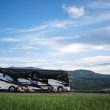When the rich hues of autumn give way to the bluster of winter, RVers either pack up and head for sunny sites in the south or southwest or pack it in until warmer days return. If the option is packing it in for the winter and heading for storage, RVers have one last adventure for the season: winterizing your RV.
While taking care of the water and waste systems is No. 1 on every winterization list, follow additional basic steps so your RV is safe through the cold months and ready to roll at the first thaw.
Plumbing and drainage systems
Protect your RVs plumbing system from the ravages of winter. How to winterize will depend on your RV — some will come with built- in systems to simplifying the process. Motorized RVs will require additional steps, while towables, from big fifth wheels to tiny pop-ups, will all need help before heading to storage. Start at with the owners’ manual for unit-specific steps for winterizing your RV.
No matter, the RV, winterizing starts with the plumbing system. For some this means using a RV-specific antifreeze for others, completely draining the plumbing system. Some RV owners opt for a combination of the two. Draining water from the RV and adding RV and Marine anti-freeze. For those who prefer to store their RV dry, draining the plumbing system begins with bypassing the hot water heater. Some RVs are equipped with a bypass valves, for others inexpensive bypass kits are available. Open all faucets and valves from kitchen to bathrooms and drain all the water from the pipes. Some owners finish off the job by blowing compressed air – at no more than 45 psi — through the plumbing. When everything is drained, depressurize and drain the hot water heater. Some RV owners will opt to go the extra mile and add pink, non-toxic antifreeze to the water systems.
Winterizing Your RV
Refrigerator
Before closing up your RV, remove all foods from your refrigerator and clean thoroughly. Even though ice makers are supposed to freeze, it’s not supposed to happen in storage so if your RV refrigerator includes an ice maker, be prepared to take some extra winterization steps. Protect the solenoid valve that sends water to your icemaker before heading to storage. The valve is located behind the refrigerator and is usually accessed from an outside panel. Check your owners’ manual for specifics about protecting your RV refrigerator’s ice maker.
Seal openings
Don’t let your RV become a warm, safe haven for insects and rodents over the winter. Pests desperate for shelter from the cold will squeeze themselves into the tiniest openings, so look for any opening, no matter small – from water lines to wall seams – and close them off. Block as many openings as you can with screens, foil or steel wool. Check seals and caulk as necessary before heading into storage. Before sealing your RV for the winter, roll-up the welcome mat and roll out the mice and bug traps in case pests manage to find their way in.
Interior
Carefully clean your interior and wipe down all surfaces. Clean out all closets and drawers and leave drawers slightly open and doors ajar. Cleaning and wiping down the surfaces in your RV is an opportunity to look for places where pests might squeeze their way in and find hidden spills and stains that will worsen while in storage. Before closing up for the winter, make sure all the surfaces, rugs and upholstery are completely dry to avoid mold and mildew.
Tires and Batteries
If possible, disconnect, remove and store your RVs batteries separately as part of your winterizing activities. Do not allow your batteries to freeze; store them in a heated environment above ground. Also, even though everything is dark for the winter, the batteries will leach power. Throughout the trailer remove batteries from clocks, smoke alarms and appliances. Inflate your RV’s tires to the maximum recommended pressure before storing your RV. If your RV will be exposed to the elements throughout the winter, park atop wood blanks to stay off asphalt and cover tires to prevent sun damage.
With careful preparation at the start of winter your RV will be clean, safe and ready to roll for next spring’s first adventure. If winterizing your RV leaves you cold, use the seasonal change to visit your trusted RV service center where your RV can be professionally prepared for winter.






